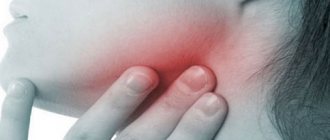What it is
Damage to the oral mucosa can be caused in a variety of ways. In a healthy person, minor injuries disappear quite quickly and without leaving a trace. In the presence of chronic diseases that reduce the level of immunity, any infection or dirt that gets into the wound provokes the development of inflammation.
Traumatic stomatitis is the result of a single or long-term impact on soft tissues, as a result of which painful formations appear in places of damage that are not characteristic of the normal state of the mucous membrane. These may be small blisters, ulcers, erosions, ulcers or wounds covered with a grayish or white coating.
Most often, with a single exposure and the absence of infectious contamination, such consequences of injury disappear quickly and without drug treatment. If soft tissue injury occurs over a long period of time (by braces, a sharp tooth fragment, tartar, dentures, etc.), gum inflammation and stomatitis can develop into a chronic form.
Types of stomatitis
Infection of the oral cavity can be caused by both viruses and protozoan microorganisms, which are an integral part of the human microflora and do not manifest themselves in any way if the immune system works without failures.
Children with low body weight, premature babies and those who often suffer from colds (respiratory) diseases are most susceptible to the development of stomatitis.
In the photo: the location of stomatitis in different parts of the oral cavity in children
Depending on the type of pathogen, several types of stomatitis are distinguished.
Viral (herpetic)
Occurs as a result of infection with the herpes virus. Children aged 1 to 3-4 years are most susceptible to this form of stomatitis. After the virus enters the body, an incubation period begins, which can last more than two weeks (in rare cases, the incubation of the virus takes 30 days).
The disease is severe: the child becomes lethargic, capricious, refuses food and water (infants can push away a bottle of milk and their mother’s breast).
Body temperature usually fluctuates between 37-38.5 degrees, but in exceptional cases it can reach 39 and even 40 degrees. In this case, we recommend reading what to do if your child has a fever. The rash characteristic of herpetic stomatitis can cover not only the oral cavity, but also areas of the face and ears. In case of moderate and severe damage, the child must be admitted to a hospital.
Fungal (candidiasis)
Candidiasis (thrush) is caused by fungi of the Candida family.
Even a newborn baby can become infected with thrush. Cases when a baby becomes infected in the maternity hospital account for about 40 percent of all candidiasis diagnosed in infants.
The main sign of pathology is a white cheesy coating covering the mucous membranes, the inner surface of the cheeks, gums, tonsils, tonsils, etc. Often, candidiasis is accompanied by glossitis - damage to the surface of the tongue. Candidal stomatitis in children is accompanied by elevated temperature (within 37.6-38.1 degrees) and a general deterioration in health.
Aphthous
This type of stomatitis rarely occurs in children under 5-7 years of age.
Pediatricians still cannot come to a consensus on what exactly causes the aphthous form of the disease. Some believe that the problem is problems with the functioning of the gastrointestinal tract; others are inclined to believe that the disease is of an allergic nature. It is the second version that is now recognized as more reliable.
With aphthous stomatitis, the baby develops aphthae - these are oval or round ulcers with clear, even edges and outlines. As the disease progresses, the aphthae becomes covered with a dense film. If it breaks through, the wound may become infected, which significantly aggravates the course of the disease and reduces the effectiveness of the therapy.
Bacterial
Caused by pathogenic bacteria, infection with which is often a complication of diseases of the oropharynx (laryngitis, tonsillitis, pharyngitis, etc.).
A separate type of stomatitis is traumatic (the result of mechanical damage to mucous areas) and allergic, which is a consequence of contact with allergens and increased production of histamine.
Causes
The causes of traumatic stomatitis may be the following:
- In children, this phenomenon is most often associated with active games and damage to the tooth or soft tissue as a result of a blow (for example, with a ball) or an unsuccessful landing on a hard object. However, this disease can also occur in infants as a result of injury to the gums by a protruding tooth.
- In the everyday life of an adult, the main cause of the onset of stomatitis can be a simple burn from hot tea. And if a person consumes very hot food and drinks systematically, such a burn and, accordingly, stomatitis, become chronic. By the way, you can get burned not only by hot food, but also by chemicals and medications used not according to instructions, acids, alkalis, and even electric shock and fire. In addition to a burn, stomatitis can also be caused by frostbite.
- Constant friction against the sharp edge of a chipped or broken tooth, poorly ground metal of braces, or poorly fitting dentures can also cause traumatic stomatitis. It is for this reason that you should not endure discomfort and pain due to the problems described above. The only correct solution would be to contact a dentist to eliminate the interference.
Another reason for the occurrence of this disease is bad habits, as a result of which the mucous membrane is injured:
- biting lips and inner cheeks;
- frequent consumption of seeds, which injures the tongue;
- haste in eating with frequent biting of the cheeks and tongue;
- the habit of holding sharp objects in the mouth and much more.
All these mechanical effects lead not only to permanent injuries to soft tissues, but also to the formation of swelling, inflammation and even ulcers.
Symptoms
Traumatic stomatitis can be distinguished from other types only by knowing the background of its occurrence, since the manifestations of symptoms of the disease are quite typical for all types:
- At the site of injury, a slight swelling or bruise first appears, the skin turns red, swells, and slight tissue hyperemia may appear;
- gradually the painful sensations increase, over time it becomes difficult to open the mouth and chew food;
- ulcers, wounds, ulcers, blisters, erosions appear;
- with severe lesions, irreversible soft tissue necrosis may occur;
- as a result of an acid burn, a dense film forms over the damage;
- until the cause of injury is eliminated, the manifestation of symptoms of stomatitis can be wave-like;
- Severe cases of traumatic stomatitis may be accompanied by suppuration or fungal infection.
Symptoms of stomatitis in children
Just like the causes of stomatitis in children, its symptoms are broad and also depend on the type of disease. In this section we will group the characteristic symptoms for each form of stomatitis in children.
Symptoms of viral stomatitis in children
The main symptom of viral (herpetic) stomatitis is the appearance of bubbles on the oral mucosa, which, after opening, form small erosions covered with plaque. Such erosions can be multiple in nature and located either at a distance from each other or merge together, forming large affected areas of the oral mucosa. They can be located on the lips, larynx, cheeks, tongue or roof of the mouth and are usually very painful and react strongly to touch, hot or cold food and other stimuli.
Symptoms of candidal stomatitis in children
Usually, before the onset of candidal stomatitis, the child experiences dryness of the oral mucosa, a burning sensation, an unpleasant taste and bad breath. Based on the baby's behavior, one can suspect the onset of the disease. As a rule, during this period, children are capricious while eating, behave restlessly, and sleep poorly. Further, as the disease develops, many small white dots appear, which form the affected area, covered with a white cheesy coating. In advanced forms of the disease, the plaque may turn gray. This indicates the transition of the disease to a severe form. In severe forms of candidal stomatitis, it is difficult to cleanse the mucous membrane of plaque and, at the slightest touch to the damaged area, it results in severe pain and bleeding.
Symptoms of bacterial (infectious) stomatitis in children
- The mucous membrane turns dark red; - The formation of yellow crusts occurs, which seem to stick together the lips; — The child experiences increased salivation; - Bad breath appears.
Also, depending on the infection that caused stomatitis, the following symptoms may be observed: the formation of fibrinous films, bleeding of damaged areas, severe plaque on the tongue.
Symptoms of aphthous stomatitis in children
With aphthous stomatitis, ulcers and aphthae form on the oral mucosa. Aphtha is a painful, round-shaped area of mucous membrane covered with fibrinous plaque. With aphthous stomatitis, children become lethargic, irritable, moody and complain of pain in the oral cavity. As a rule, aphthous stomatitis is chronic and can worsen 1–2 times a year.
Treatment
Like any serious disease, traumatic stomatitis requires immediate treatment. First of all, the doctor will have to eliminate the source of injury:
- In the case of a broken or chipped tooth, it is necessary to cure or remove this tooth, depending on the depth of the damage.
- Braces and dentures are improved or remade from higher quality material.
- Tartar is removed and the sharp edge of the tooth is ground down.
- If there are minor injuries, wounds and cracks are washed with antiseptics (peroxide, furacillin, infusions of calendula or chamomile).
- More serious injuries are numbed and treated with anti-inflammatory drugs.
- For quick healing of wounds, ulcers and erosions, your doctor may recommend applications with rosehip or sea buckthorn oils, vitamin A oil solution and other keratoplasties.
- In cases of thermal burns or frostbite, applications of an anesthetic drug may be necessary, but in case of a chemical burn, you must first thoroughly rinse the damaged area with a neutralizer. For an acid burn, use an alkali solution, and for an alkaline burn, accordingly, use an acid solution. And only after eliminating the traumatic substance is further treatment with antiseptics and anesthetic rinses possible.
Pediatric stomatitis
Treatment of mild herpetic stomatitis
Thanks to timely consultation with a doctor, the inflammatory phenomena subside within a week.
Antiseptic rinses (spray irrigation)
Antiseptic solutions destroy pathogenic microflora of the oral cavity, protecting against the addition of a secondary infection. Your doctor may prescribe rinsing 3-4 times a day for 15 minutes. Convenient to use spray irrigation when the child refuses rinsing. After using the antiseptic solution, you should refrain from eating for about an hour.
Pain relieving anti-inflammatory gel
Anesthetic gels contain an anesthetic solution. They are used to treat painful erosions before eating. The gel is applied for 5 minutes to the surface of the erosion in a thin layer.
Keratoplasty (drugs to stimulate mucosal healing)
After the inflammatory phenomena subside, oil solutions of vitamins are used for external use. They improve metabolic processes in the epithelium, which accelerates the healing of erosions. Sterile gauze wipes soaked in an oil solution are applied to the erosions for 7-10 minutes. After this, you should also refrain from eating so as not to remove the formed film from the erosion.
Treatment for the presence of lesions on the skin around the mouth and the red border of the lips
After the bubbles open, crusts form. Their mechanical removal provokes the formation of other bubbles. Crusts on the lips make it difficult to speak and eat. Violation of their integrity opens the bleeding mucosa.
Therefore, crusts must be treated with solutions of proteolytic enzymes to soften and remove them. Oil solutions of vitamins are also used to heal the skin and mucous membrane underneath. Lips are treated with moisturizing balms to prevent them from drying out.
Special food and feeding
Food should not further irritate the inflamed mucous membrane, therefore it is recommended:
- make food liquid, at room temperature;
- exclude sour, salty foods;
- Before eating, treat erosions with anesthetic gel.
Oral hygiene for stomatitis
Maintaining hygiene is one way to combat re-infection of the mucous membrane. Also, all treatment solutions must be applied to a clean surface. After each meal, it is necessary to rinse the mouth with plain water to prevent the development of pathogenic microflora.
The herpes simplex virus is contagious and can enter a child’s body through environmental objects (shared dishes, toys). Therefore, it is necessary to treat them and protect a child with herpetic stomatitis from contact with other children.








